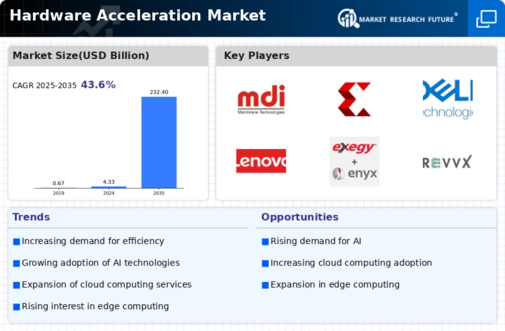Top Industry Leaders in the Hardware Acceleration Market

The Competitive Landscape of the Hardware Acceleration Market
The hardware acceleration market, a pulsating ecosystem where processing power meets specific functionalities, is revving up for significant growth. Understanding the strategies, key players, and future trends is crucial for businesses to navigate this dynamic terrain and capitalize on its potential. Buckle up as we explore the intricate network of adopted strategies, factors influencing market share, rising newcomers, and the overall competitive scenario.
Key Player:
- NVIDIA Corporation
- Intel Corporation
- Advanced Micro Devices Inc.
- Achronix Semiconductor
- Oracle Corporation
- Xilinx Inc.
- IBM Corporation
- Hewlett Packard Enterprise Company Dell
- Lenovo Group Limited
- Fujitsu Ltd
- Cisco Systems Inc.
- VMware Inc.
Strategies Adopted by Leaders:
- Diversification and Specialization: Leading players like Intel and NVIDIA are expanding beyond traditional graphics processing units (GPUs) and field-programmable gate arrays (FPGAs), offering application-specific integrated circuits (ASICs) and neural processing units (NPUs) tailored for specific tasks like AI inference and machine learning. This broadens reach and caters to diverse computing needs.
- Focus on Performance and Efficiency: Delivering raw speed and efficient energy consumption is paramount. AMD prioritizes high-bandwidth memory and optimized chip architectures for maximum performance, while Xilinx focuses on energy-efficient FPGA solutions for edge computing applications.
- Software Integrations and Development Tools: Providing robust software development kits (SDKs) and simplifying programming models is crucial for user adoption. Arm focuses on open-source tools and developer ecosystem building, while Cadence Design Systems prioritizes easy-to-use design tools for ASIC development.
- Partnerships and Acquisitions: Strategic partnerships with chipmakers, cloud providers, and software vendors accelerate technology development and market access. Qualcomm collaborates with Microsoft on Azure cloud accelerators, while Alibaba Cloud partners with Xilinx on customized AI hardware solutions.
- Focus on Emerging Applications and Markets: Addressing specific needs can be lucrative. Achronix targets high-performance computing and financial markets with its FPGAs, while Cerebras Systems focuses on large-scale AI training with its wafer-scale AI chip architecture.
Factors for Market Share Analysis:
- Brand Reputation and Installed Base: Established players like Intel and NVIDIA hold an advantage with proven track records, extensive deployments in data centers and high-performance computing environments, and strong relationships with technology giants. This legacy inspires trust and repeat business.
- Technology Portfolio and Breadth: Offering a diverse range of accelerators with varied capabilities and price points caters to different application types, budget constraints, and computing requirements. Xilinx's comprehensive portfolio of FPGAs and adaptive computing solutions exemplifies this approach.
- Performance Benchmarks and Energy Efficiency: Delivering the highest processing power for specific tasks while consuming minimal energy is a key differentiator. AMD's Radeon Instinct GPUs often top performance charts, while NVIDIA's Tensor Core technology excels in AI workloads.
- Ease of Use and Developer Support: Intuitive programming models, comprehensive documentation, and active developer communities attract users and drive adoption. Arm's open-source tools and ecosystem building efforts are a model for ease of use, while Cadence Design Systems offers extensive technical support for ASIC development.
- Focus on Niche Applications and Partnerships: Addressing specific needs can be lucrative. Synopsys targets the automotive industry with its AI hardware for autonomous driving, while Graphcore excels in high-performance graph processing applications.
New and Emerging Companies:
- Movidia: Pioneering AI accelerators optimized for high-performance inference at the edge.
- Tenstorrent: Leading the charge in low-power AI accelerators for mobile devices and Internet of Things (IoT) applications.
- Groq: Developing innovative software solutions for optimizing and managing hardware acceleration across diverse platforms.
- Blaize: Focusing on customizable neural processing units for diverse AI workloads, offering flexibility and efficiency.
Latest Company Updates:
NVIDIA Corporation:
- October 20, 2023: NVIDIA unveils the H100 GPU with 80GB HBM3 memory, boasting significant performance leaps for AI training and scientific computing
- July 12, 2023: NVIDIA announces Grace CPU SuperCluster platform, integrating its BlueField data processing units (DPUs) with AMD Genoa CPUs for high-performance computing at the edge
Intel Corporation:
- October 17, 2023: Intel showcases Ponte Vecchio GPUs optimized for AI workload acceleration, featuring Xe HPC architecture and advanced memory technologies
- July 6, 2023: Intel unveils its next-generation Xeon CPU with integrated Habana AI accelerators, catering to AI inference needs in data centers and cloud environments
